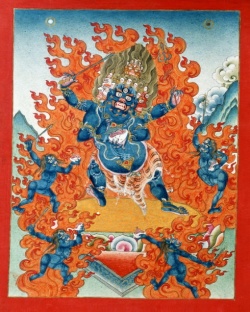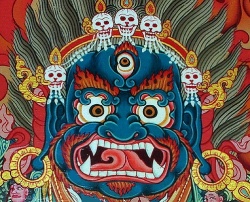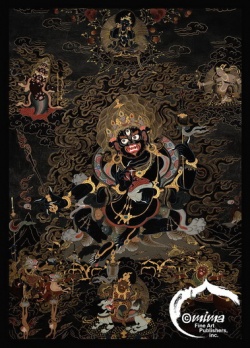Four faced Sri Mahakala
zhal bzhi pa sgrub dus dang 'brel ba
dpal mgon zhal bzhi pa sgrub dus dang 'brel ba
English
four faced sri mahakala connected with the period of accomplishment
Notes
this deity topic is applied to empowerments and rituals for the the four faced mahakala, whos principal face is black and eating a human corpse; he is very wrathful and fierce; his right face is white and loudly laughing; his left red, smiling and terrible; his upper face is smoke colored with bared fangs; the skull in his first left hand is filled simply with the heart of the hindering enemy; his other left hand brandishes a bone rosary in stopping manner ('gag thabs su) and holds a trident; under his arm is tucked a golden flask full of nectar.
his attendants are just as in deities of tibetan buddhism #385:
b) on his right is the great mother, black dombini (g.yung mo);
c) on his left, the worker (las mkhan) green candali (gtum mo);
d) in front dark red maharaksasi (srin mo chen mo);
e) behind dark yellow simhali (sing+ga gling ma),
each is one-faced and two armed holding a knife and a skull, extremely fiece and wrathful and with the attributes of a female messenger, three eyed, naked and without ornaments, in a great hurry and facing the principal; encircling them round the outside are twenty-one demon-slashing butchers, twenty-one thousand demon-subduing soldiers, and the proud beings of the eight tribes of gods and spirits, with an entourage as numerous as the atoms of the world.
the four faced vajra mahakala, mighty strength sapping field protector is invoked from kailash, sitavana, potala and the loud laughing charnel ground
deviations: the colors of e)
www.tbrc.org
Mahakala, Chaturmukha (Four-faced Great Black One) associated with the Guhyasamaja Tantra along with the Twenty-five and Fifty Chapter Mahakala Tantras. There are also Nyingma Revealed Treasure Traditions (terma) of Chaturmukha.
According to the Sakya Tradition this form of Mahakala with four faces and four arms is rarely depicted in art and virtually never shown to those who are uninitiated. The early Sakya Teachers devised a simplified form of the deity to be depicted on paintings as a place card-holder for the true image and form which was considered too secret and dangerous to display publicly. The simplified form is that of what has come to be known as Brahmanarupa Mahakala. (See below for a short history).
"Shri Vajra Chaturmukha Mahakala, the main face and the stacked face are both black, the two on the right and left are dark green. With four arms, the first two right and left hold a curved knife and blood filled skullcup to the heart. The lower right [holds] a sword. The lower left holds upraised a bone garland [of beads]. The brown hair bristles upwards; there are three eyes, bared fangs, lower lip distended, a crown of five dried skulls, a necklace of fifty fresh [heads], a brahmin's cord, bone and snake ornaments. [He] stands in a manner with the right leg bent and the left straight; having an appearance of magnificent wrathfulness. On the right is black Dombini, left green Chandali, front red Rakshasi, behind yellow Singhali." (by Ngorchen Konchog Lhundrup (1497-1557). Lamdre Collection, vol.18, folios 375-398. sGrub Thabs Kun bTus, vol.10., fol. 400-422. Gyu De Kun Tus, vol.18, fol.128-150).
In paintings Chaturmukha Mahakala is typically depicted in his form known as the Accomplishment. In this form he has four faces, four arms and two legs. The main face is blue-black and the right white and the left red. The top face is smokey coloured. The first pair of hands hold a curved knife and a skullcup. The second pair of hands holds a raised sword in the right and a spear in the left. The right leg is bent and the left straight standing atop a prone corpse-like figure. Standing in front, ghoulish in appearance, dynamic in posture, are the four attendant dakinis; Dombini, Chandali, Rakshasi and Singhali Devi - black, red, yellow and green in colour. This is the description for the main form of the deity that appears most often in art.
Chaturmukha also has a number of different variations in form and function. His body colour can change according to activity such as white for long-life, yellow for wealth and red for power. The objects in the hands can change and the colours of the four dakinis along with their hand objects can change. There is also a form of Chaturmukha that has four demon heads. Most commonly these variations in form are only found as depictions in sets of Initiation Cards.
A Short History of Chaturmukha & Brahmanarupa Mahakala: When the great Tibetan Translator Nyen Lotsawa received the Manjuvajra Guhyasamaja (also known as the Jnanapada Lineage) empowerment from the dakini Risula, she also bestowed the initiation of the Mahakala (Chaturmukha) in the special form according to the Guhyasamaja Tantra. At this time she gave him as a servant a dark skinned Brahman. When Nyen Lotsawa and the Brahman reached Nepal the servant changed appearance and took on the form of a monk, an appearance more conducive for travelling in Tibet. After the passing of Nyen Lotsawa the monk remained with Lama Nam Ka'upa and then later with Sachen Kunga Nyingpo.
Brahmanarupa Mahakala is none other than Chaturmukha Mahakala of the Guhyasamaja Tantra. In his wrathful appearance he is black in colour with four faces and four hands, surrounded by the four dakinis. In the Sakya School it is inappropriate to show the wrathful form to anyone who has not received the initiation. For this reason the iconographic tradition arose for painting Chaturmukha in the form of the Brahman servant of Nyen Lotsawa. At the bottom of many Sakya paintings it is a common theme to see Panjarnata Mahakala flanked by the Brahman on the right and Shri Devi (Palden Lhamo) on the left - the three main protectors of the Sakya School.
In later times the Gelug School of Tsongkapa adopted the Guhyasamaja practices and the Chaturmukha Mahakala. Many more paintings and depictions of the four faced deity were made and less emphasis was placed on secrecy. The vast majority of Tibetan and Mongolian paintings of Chaturmukha are Gelugpa.
Indian Lineage: Vajradhara, Nagarjuna, Balimtapa, Buddhajnana, Marmedze Zangpo, Shrideva, Drime Bepa, Ratnavajra, Ratnakirti, Risula Dakini, Nyen Lotsawa, Lama Nam Ka'upa, Sachen Kunga Nyingpo, etc.
Taranata in his text called an Ocean of Meditational Deities (Yidam Gyatso) describes Chaturmukha Mahakala as having Five types: 1. Approximation, 2. Accomplishment, 3. Performing Activities, 4. the Four Families, or Four Activities, and 5. Demon Faces. The technical descriptions of the various forms of Chaturmukha vary between the text of Taranata and the Rinjung Lhantab text of the 4th Panchen Lama.
Chaturmukha Iconographic Forms:
1. Approximation: 40575, 202142
The center face is blue and upper face smokey. The right and left faces are green. The 4th Panchen describes the right face as green and the left face as black.
2. Accomplishment:
The center face is blue and upper face smokey. The right face is white and the left red.
3. Performing Activities: 40577, 202144
The center face is blue and upper face smokey. The right face is white and the left red. The tradition of the 4th Panchen Lama teaches two blue stacked faces on the right and two green stacked faces on the left. (See example).
4. Long-life: 40578, 202145
The form is white in colour along with four white dakinis.
5. Wealth: 40579, 202146, 81673
The form is yellow in colour along with four yellow dakinis.
6. Power: 40580, 202147, 81672
The form is red in colour along with four red dakinis.
7. Practicing Liberation: 40581, 202148, 81671
the form is dark blue in colour and the four dakinis are dark blue each holding a sword in the right hand.
8. Demon Faces: 40582, 48117, 202149
The four faces are of a wrathful figure, elephant, buffalo and a lion. This form of Chaturmukha has six arms.
9. Chaturmukha (Nyingma Treasure Tradition [[[terma]]]): 3314575
This form is essentially the same as the Accomplishment Chaturmukha except with the addition of wings.
10. Chaturmukha (Nyingma Treasure Tradition [[[terma]]]): 52512
This form is essentially the same as the Accomplishment Chaturmukha except with the addition of a consort and wings.


